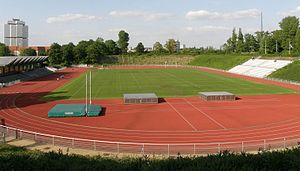Wilmersdorf Stadium
| Wilmersdorf Stadium | |
|---|---|

|
|
| The Wilmersdorf stadium in May 2009 | |
| Data | |
| place | Fritz-Wildung-Strasse 9 14199 Berlin , Germany |
| Coordinates | 52 ° 29 ′ 1.8 ″ N , 13 ° 18 ′ 10 ″ E |
| opening | March 10, 1951 |
| First game | March 10, 1951 Berliner SV 92 - Tennis Borussia Berlin 1: 1 |
| Renovations | 1991, 2005 |
| surface | Natural grass |
| architect | Wils Ebert |
| capacity | 4000 seats |
| playing area | 103 m × 66 m |
| Societies) | |
|
|
| Events | |
The Wilmersdorf Stadium is a sports stadium with a grass field and athletics facilities in the Berlin district of Schmargendorf . The sports facility was built between 1948 and 1951 and currently offers space for 4,000 spectators. It is mainly used for soccer , American football, and athletics .
Location and facilities
The facility is located in the north of Schmargendorf on a sports area on which the Horst-Dohm-Eisstadion , the Wilmersdorf summer pool , the Wilmersdorf II municipal pool , the Forckenbeckstraße sports field, the Horst-Käsler sports hall, the Werner Ruhemann sports hall and the Harald are located -Mellerowicz sports hall and the Wilmersdorf tennis club are located. This area is bounded by the city motorway , Forckenbeckstraße , Cunostraße and Fritz-Wildung-Straße (formerly: Lochowdamm ). The closest express train stations are the Hohenzollerndamm S-Bahn station and the Heidelberger Platz S- Bahn and U-Bahn station
The name of the stadium and other facilities on the site was the Wilmersdorf district , which existed until 2000 and is now part of the Charlottenburg-Wilmersdorf district .
In addition to the actual main stadium, there are three large playing fields and one small field, each with artificial turf. In addition to the soccer field, the main stadium has a 400-meter circular running track and several athletics facilities.
history
The history of the sports facility has its origins in 1909, when the BTuFC Britannia built the Britannia sports field next to the then Berlin gasworks V on Forckenbeckstrasse . The BTuFC Britannia was renamed in 1914 in "Berliner SV 92". After the gasworks had been shut down and demolished by 1934, the Wilmersdorfer district administration had an extensive sports facility built on the vacated site, including the stadium on Lochowdamm . Field handball games were held here during the 1936 Olympic Games .

The entire facility was badly damaged in World War II. In 1945 the area was divided into allotment gardens and the tenants were able to supplement their diet with their own vegetables and fruit. The gardens were cleared in 1947 so that rubble debris from the Wilmersdorf district could be deposited there. By means of a debris path and the use of carts ensured up to 300 people as part of the postwar usual relief work for the orderly disposal of a total of 1.1 million cubic meters of rubble, the fitting-out of a small grandstand and the subsequent planting of landfills. At the official inauguration of the new sports grounds on May 5, 1951 by the Governing Mayor of Berlin, Ernst Reuter , it was named Stadion Wilmersdorf , referring to the former Berlin district of Wilmersdorf , in which the stadium was located. The capacity at that time was 50,000 spectators.
The stadium experienced its most important sporting period in the 1953/1954 season, when the Berliner SV 92 became champions of the Berlin contract league and attracted an average of more than 6,000 spectators at their home games. Since 1974, the stadium has been accessible from the Wilmersdorf district via the Hoher Bogen pedestrian bridge , which spans both the ring railway and the city motorway .

The capacity of the stadium proved to be overdimensioned in the long run. Even the audience record of March 10, 1951, when 19,500 onlookers wanted to watch the match between Berliner SV and Tennis Borussia Berlin , is far below capacity. Therefore, a vineyard was laid out in 1984 on the grandstand wall of the north curve , on which the Wilmersdorfer Rheingauperle thrives. In 1991 the stadium was given a synthetic track and a new main stand, which is partially covered by the protruding roof of the Horst-Käsler-Halle.
From July 11th to 17th, 1993 the Xth International Fire Brigade Competitions of the World Fire Brigade Association CTIF (Fire Brigade Olympiad ) were held in the Wilmersdorfer Stadium . The program of the world championships , which take place every four years, included traditional international fire service competitions, international fire service sports competitions and international youth fire service competitions .
As part of a renewed renovation, a new grandstand was also laid out on the back straight in the middle of the old grandstand wall. The remaining former stands have been renatured .
literature
- Angela M. Arnold, Gabriele von Griesheim: rubble, railways and districts. Berlin 1945–1955 . Self-published 2000, pp. 251-253
- Werner Skrentny (Hrsg.): The big book of the German soccer stadiums . Verlag Die Werkstatt, 2001, p. 56
Web links
- Technical data of the system
- Wilmersdorf Stadium - Berlin-Wilmersdorf
- Stadium Wilmersdorf Nebenplatz 1 (KR) - Berlin-Wilmersdorf
- Stadium Wilmersdorf Nebenplatz 2 (KR) - Berlin-Wilmersdorf
- Pictures and data of the stadium
- History of the stadium
- Brief information on the stadium district lexicon on berlin.de
Individual evidence
- ^ Franz-Josef Sehr : X. Fire Brigade Olympics 1993 in Berlin . In: Florian Hessen 9/1993 . Munkelt Verlag, Wiesbaden 1993, p. 25-26 . ISSN 0936-5370 .
- ↑ Stadium starts operations . In: Berliner Zeitung , September 12, 2005